Sub-Projects
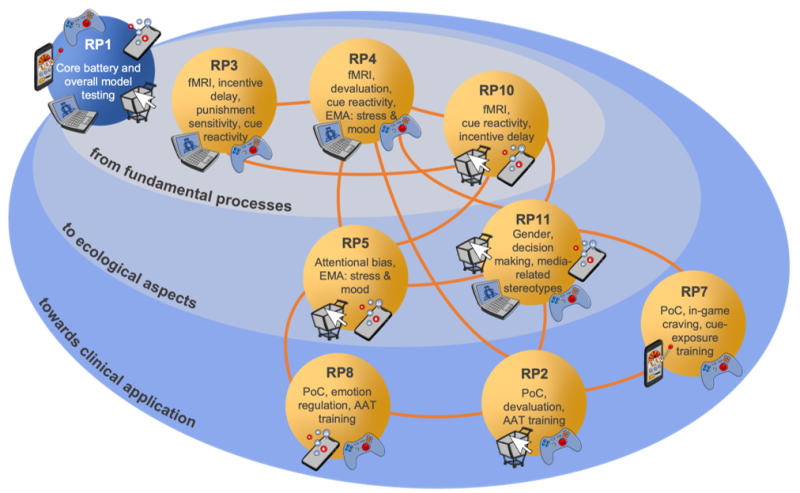
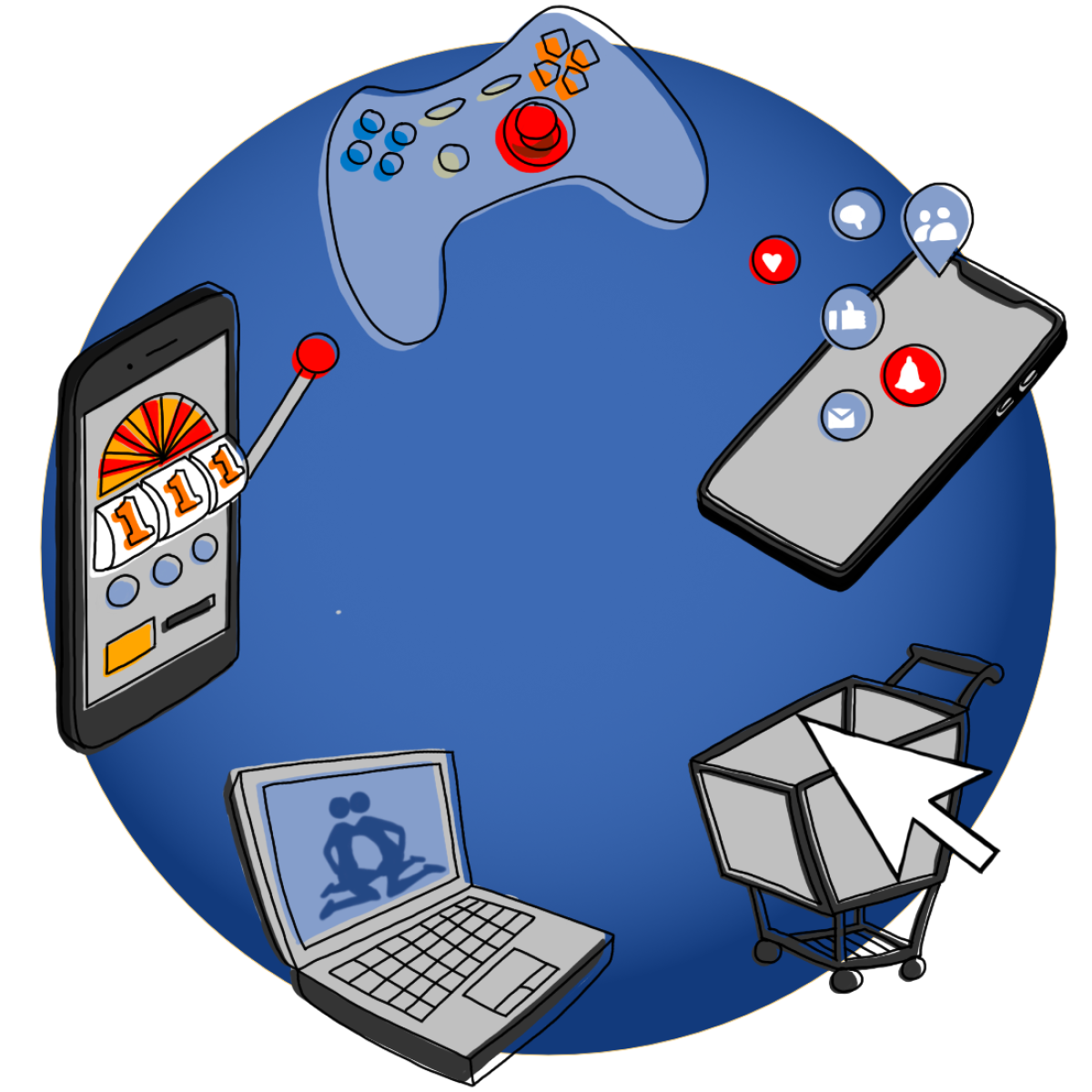
RP1: Comprehensive model testing, comparison of cohorts, and longitudinal approach
The theoretical model of the FOR 2974 research group, the I-PACE model, examines core mechanisms such as cue-reactivity, craving, cognitive distortions and executive functions in relation to addictive behaviour. RP1 uses data to replicate previous findings, analyse cohort effects and integrate longitudinal data. The aim is to test hypotheses on predictors, moderators and mediators of Internet use disorders (INS) and to explore differences in the stages of INS. This includes both cross-sectional comparisons and longitudinal studies over three years to investigate changes in affective and cognitive mechanisms and their relationship with symptom severity.
Read more
The theoretical model underlying FOR 2974 and thus the composition of the core battery coordinated via RP1 is the I-PACE model (Interaction of Person-Affect-Cognition-Execution). The I-PACE model comprises hypotheses on core mechanisms that are systematically recorded in the FOR 2974 core battery: Cue-reactivity and craving, cognitive distortions, approach/avoidance tendencies, usage expectations, decision-making behaviour, executive functions and inhibitory control, as well as impulsivity and compulsivity as transdiagnostic concepts that can particularly distinguish between early and later stages of addictive behaviour. RP1 will use the data from the core battery to pursue the following objectives: 1) replication of the results from the first funding period, 2) analysis of potential cohort effects and, if these are not found, merging of both cohorts to enrich the sample for complex analyses, 3) merging of the data from the first and second funding period from individuals who participated in both surveys (target: 50% of participants from the first funding period) in order to analyse the data longitudinally, and 4) analysing new measures that were included in the core battery for the second funding period. RP1 tests the overarching hypotheses of FOR 2974 regarding the role of predictors, moderators and mediators in explaining symptoms of Internet use disorder (INS) (testing vulnerabilities) as well as similarities and differences across INS (testing specificities). The potential shift from early to later stages of INS and the corresponding mechanisms (e.g., stronger cue-reactivity and additional involvement of cue-specific inhibitory control in later stages) will be addressed by a cross-sectional comparison of participants with risky and pathological use of specific applications. This approach will be complemented by a longitudinal study (testing causality), which will again include a six-month follow-up survey and which will bring together the data from the core battery of participants in both funding periods to map a three-year course. In doing so, we aim to investigate how affective and cognitive mechanisms may change over the course of INS and how this covaries with the course of symptom severity (or recovery from INS).
Project members
Principal Investigator: Prof. Dr. Matthias Brand
Members: Andreas Oelker, Niklas Meurer
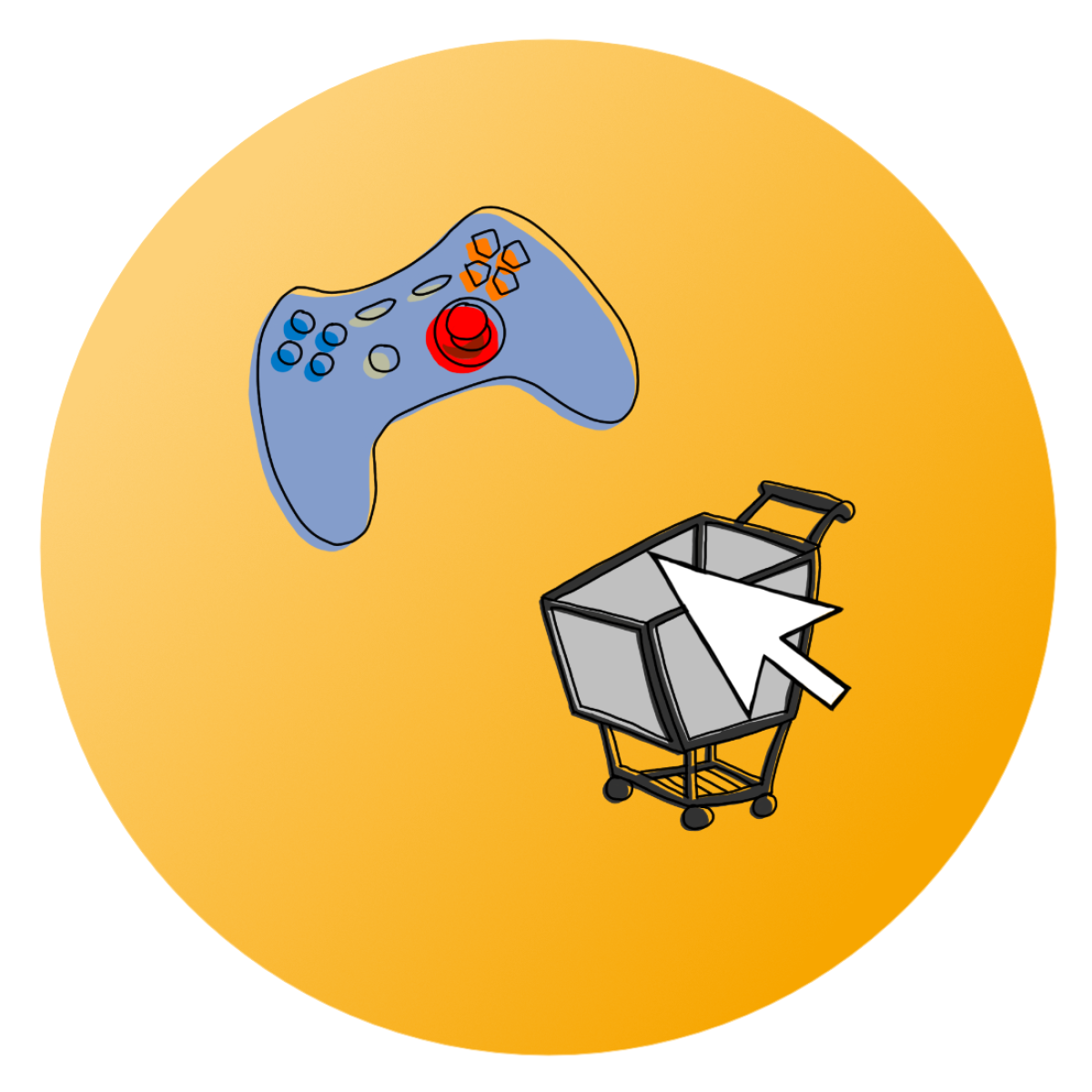
RP2: Devaluation of reward value in gaming disorder and buying-shopping disorder – psychological mechanisms and proof-of-concept study
The influence of conditioned stimuli plays an important role in addictive disorders, as they can reinforce reward-related behaviour, as the Pavlovian-to-instrumental transfer (PIT) effect shows. Even when rewards are no longer available, these stimuli continue to influence behaviour. A proof-of-concept study will now investigate the effectiveness of a modified Cognitive Bias Modification (CBM) approach, in which addictive stimuli are linked to negative consequences in order to reduce their reward value. The study includes 252 participants with risky use of computer games or shopping applications and will evaluate their behaviour before and after the intervention as well as in everyday life.
Read more
The influence of conditioned stimuli on behaviour is considered an important aspect in the development and maintenance of addictive disorders. We were able to show that the presentation of application-specific stimuli in individuals with risky use of computer games or shopping websites reinforces the instrumental behaviour to obtain corresponding rewards, a so-called Pavlovian-to-instrumental transfer (PIT) effect. Although the devaluation of the reward (i.e., the message that rewards are no longer available) reduced the reward-related response, the presentation of the conditioned stimuli still influenced the reward-associated behaviour. It is therefore crucial to further deepen our understanding of how reward-related behaviour can be effectively reduced. Research on substance use disorders suggests that various interventions can lead to a devaluation of substance-related stimuli. In terms of clinical outcomes (e.g. relapse rates), the evidence in favour of Cognitive Bias Modification (CBM) to reduce alcohol-related approach tendencies is most convincing. However, no effects of CBM on an alcohol-related PIT effect have been demonstrated to date. The few available studies on Internet use disorder provide evidence for an effectiveness of CBM on gaming disorder, but also suggest that systematically linking addiction-associated stimuli to negative stimuli (i.e. evaluative conditioning) could be an effective method to reduce the reward value of addiction-related stimuli. Against this background, a proof-of-concept study will be conducted to investigate the effects of devaluation-modified CBM (DEV-CBM) compared to traditional CBM on affective and cognitive mechanisms. In DEV-CBM, stimuli associated with computer games/online shopping are systematically linked to stimuli that represent individual negative consequences of application use. Participants with at least risky use of computer games (n=126) or shopping applications (n=126) are randomly assigned to DEV-CBM or CBM. The survey consists of three parts. At t1, the FOR2974 core battery is carried out. At t2, the DEV-CBM/CBM is performed and the PIT effect, cue-reactivity and approach tendencies are experimentally recorded before and after the training sequence. Subsequently, a five-day end-of-day Ecological Momentary Assessment will take place to test the effect of training on cue-reactivity, craving and gratification through application use in everyday life. RP2 is closely linked to RP7 and RP8, which are also conducting proof-of-concept studies on the influenceability of affective and cognitive mechanisms.
Project members
Principal Investigator: Prof. Dr. Sabine Steins-Löber, Prof. Dr. Dr. Astrid Müller
Members: Anna Schmid, Niklas Meurer, Damla Burgac, Patricia Schaar
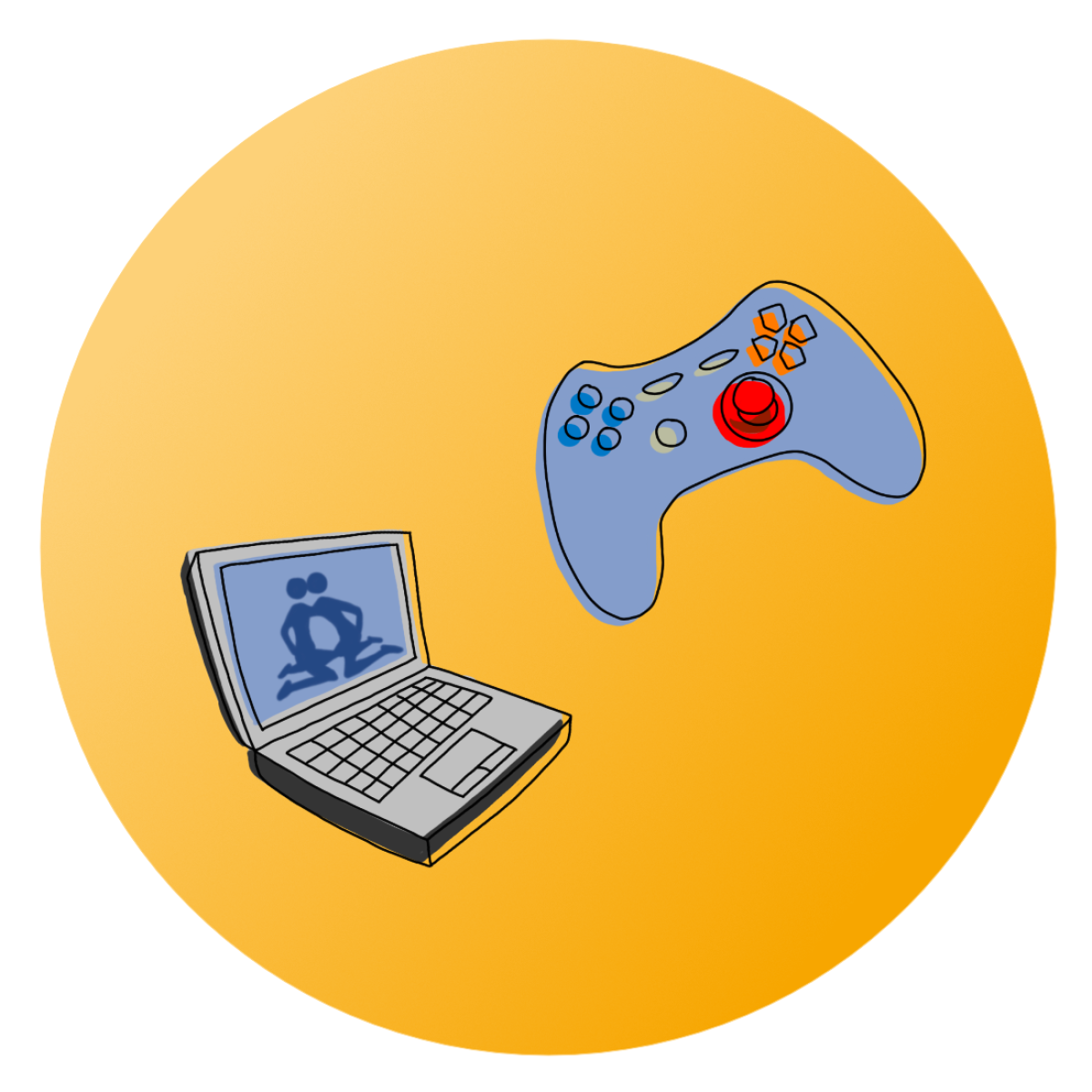
RP3: Shift from reward-driven to compulsive behaviors: The role of reduced punishment sensitivity in gaming disorder and pornography use disorder
Gaming and pornography use disorders are characterised by continued behaviour despite negative consequences, whereby punishment sensitivity has been neglected to date. This describes the adaptive suppression of a behaviour in response to negative consequences and can change in addictive behaviours. A study is now investigating punishment sensitivity in people in various stages of these disorders and in control subjects using fMRI and Ecological Momentary Assessment in order to determine the neural and behavioural correlates. The type and temporal contingency of the consequences will also be taken into account.
Read more
Both gaming disorder (GD) and pornography use disorder (PUD) are characterised by the fact that the respective behaviour is continued despite negative consequences. While most current addiction theories focus on reinforcement learning in the development of addiction, sensitivity to punishment has been neglected to date. Punishment sensitivity describes the adaptive suppression of behaviour in response to negative consequences. It is a personal characteristic that varies in the general population, but can also change over the course of disorders such as addictive behaviours. Using an innovative approach, we aim to investigate the behavioural and neural correlates of punishment sensitivity in individuals at different stages of GD and PUD as well as in healthy controls. We hypothesise that punishment sensitivity is reduced in individuals with GD and PUD. We want to find out whether this effect is specific to negative consequences resulting from addictive behaviour and whether the type of consequences (positive/negative punishment, reward/compensation) and the temporal contingency (short- or long-term consequences) influence punishment sensitivity in the natural environment. Six groups of male participants will be studied using fMRI: participants with unproblematic, risky and pathological use of games and participants with unproblematic, risky and pathological use of pornography (N=162, 27 per group). We will use a modified version of the well-studied Reward Incentive Delay Task, in which the reward (game-related, pornographic or neutral video clips) is combined with aversive stimuli in some sessions. The experimental design makes it possible to determine the degree of general and addiction-specific punishment sensitivity on the basis of behavioural and neural measures. Using an Ecological Momentary Assessment (EMA), we will investigate the nature and temporal contingency of positive and negative consequences that result from addictive behaviour in everyday life and how these consequences influence craving and the performance of addictive behaviour. We will investigate relationships between punishment sensitivity measured experimentally and in daily life by combining imaging data and EMA data with novel statistical methods such as connectome-based predictive modelling. The research focus of RP3 is on punishment sensitivity as a factor that explains the switch from reward-driven to compulsive behaviour in GD and PUD. The focus on cue-reactivity (RP4, RP10) and cue evaluation (RP2, RP4) as well as the use of fMRI (RP4, RP10) result in overlaps with RP4, RP2 and RP10. Further synergy effects are expected with RP5 and RP11.
Project members
Principal Investigator: Prof. Dr. Rudolf Stark, Dr. Stephanie Antons
Members: Kseniya Krikova, Dzheylyan Kyuchukova, Aron Lichte

RP4: Automatic and habit-like cue-reactivity responses in gaming disorder and pornography use disorder: Effects of acute stress and cue devaluation on subjective, behavioral, psychophysiological, and neural correlates
Cue-reactivity and craving are central mechanisms of addictive behaviour that are reinforced by stress and can be influenced by automatic habits. This study examines individual and situational factors, such as stress reactivity, stress susceptibility, habit propensity and glutamate metabolism, as modulators of cue-reactivity in gaming and pornography use disorders. It consists of three parts: Magnetic Resonance Imaging (MRI), Ecological Momentary Assessment (EMA) and laboratory studies to assess the neural and behavioural aspects of cue-reactivity and habits. The aim is to clarify the role of stress and neuronal habits in the development and maintenance of addictive behaviour.
Read more
Cue-reactivity and craving are central mechanisms of addictive behaviour. Cue-reactivity can become automatic or habitual from early to later stages of addiction development. Stress can act as a catalyst for automatic/habitual neural processing and as a trigger for cue-reactivity. Habits are conceptualised as behavioural or mental reactions that are not or less purposeful and persistent in the face of devaluation. Individual differences in the learning of habits can be a predisposing factor for the development of cue-reactivity. At the neurotransmitter level, an increased tendency to habits can be explained by individual differences in glutamate metabolites in the dorsal striatum. So far, the extent of automated/habitual cue-reactivity and possible modulators have not been systematically investigated in behavioural addictions. We will address individual and situational factors, such as acute stress reactivity, stress susceptibility, habit propensity and glutamate metabolism as modulators of cue-reactivity, as mental habit in the context of gaming disorder (GD) and pornography use disorder (PUD). The study consists of three parts: 1) Magnetic Resonance Imaging (MRI), 2) Ecological Momentary Assessment (EMA), 3) Laboratory (LAB). Acute stress as a catalyst of habitual neural cue-reactivity processing will be investigated using the ScanSTRESS-C, a control condition and a subsequent cue-reactivity paradigm. For correlative analyses, a high variance of GD/PUD symptom severity in each group (stress/no-stress x gaming/pornography) is aimed for (N = 132; 66 per behaviour, all male). In addition, glutamate levels in the putamen will be analysed as an indicator of habit propensity. Within the EMA, daily use of computer games/pornography will be assessed in combination with perceived daily stress, craving, mood and cortisol response. In the LAB session, we will use a contingency degradation task and a cue reactivity and devaluation task as indicators for a general tendency towards habits and the degree of automated/habitual cue-creativity. For the EMA and LAB part, we use a mixed-method cross-sectional design with six groups (N = 132; 22 per group: individuals with 1) GD and 2) risky gambling behaviour, 3) PUD and 4) risky pornography use, control participants 5) with unproblematic gambling behaviour and 6) with unproblematic pornography use). The research focus of RP4 on cue-reactivity and stress is closely linked to RP5 (focus on stress) and RP10 (focus on cue-reactivity). Further synergy effects are expected with RP2, RP3, RP7 and RP11.
Project members
Principal Investigator: Dr. Stephanie Antons, Prof. Dr. Martin Diers, Prof. Dr. Oliver T. Wolf
Members: Kjell Büsche, Lukas Mallon
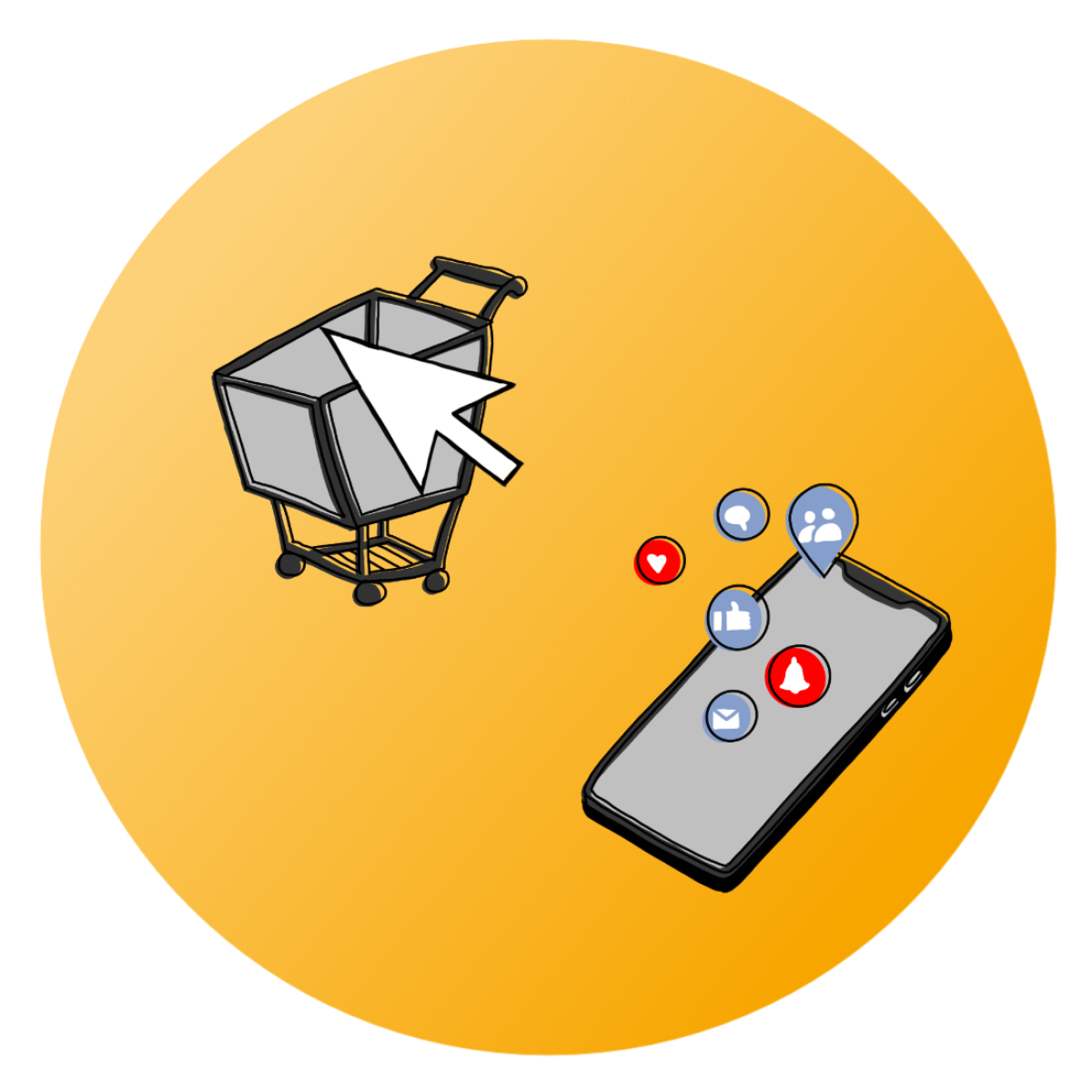
RP5: Daily stress, attentional bias, and inhibitory control in buying-shopping disorder and social network use disorder
According to the I-PACE model, affective reactions to addiction-related stimuli, attention distortions and reduced inhibitory control are central mechanisms in behavioural addictions such as buying-shopping disorder (BSD) and social network use disorder (SNN). Stress intensifies these psychological processes. In the second funding period, RP5 investigates the role of stress in KShS and SNN in everyday life and conducts behavioural tests in the laboratory to analyse attention processes and inhibition control. Possible gender effects are also taken into account.
Read more
According to the I-PACE (Interaction of Person-Affect-Cognition-Execution) model, the interaction of affective responses to addiction-related conditioned stimuli with attentional biases and reduced inhibitory control is a key mechanism in the development and maintenance of behavioural addictions, including buying-shopping disorder (BSD) and social network use disorder (SNN). Stress is thought to exacerbate these psychological processes. In the first funding period, RP5 investigated the impact of acute stress on affective and cognitive processes in women with KShS or SNN using the Trier Social Stress Test. In the second funding period, RP5 also addresses the role of stress in CSD and SNN, but now under everyday conditions. In addition, attention processes and inhibition control will be investigated using behavioural tests in the laboratory. RP5 will include women, men and non-binary individuals to explore potential gender effects and will include individuals with pathological use of online shopping applications (KShS group, n=60) or social networks (SNN group, n=60) and two age and gender matched control groups with unproblematic use of the respective internet application (n=60 each). The project is divided into three parts: two individual laboratory sessions with experimental paradigms (t1, t2) and a 5-day Ecological Momentary Assessment (EMA). At t1, all participants work on the extensive FOR2974 Core Battery and are introduced to the subsequent EMA, which examines the relationships between stress experience and specific application use in everyday life. The EMA will be combined with self-sampling of saliva to measure the stress biomarkers cortisol (as an indicator of HPA axis activation) and alpha-amylase (as an indicator of sympathetic nervous system activation). At t2, participants will complete a change-blindness flicker task with eye-tracking and a stop-signal task. The flicker task uses a complex stimulus configuration to measure both orienting and sustained attention processes. The stop-signal task is intended to measure the inhibition performance of already initiated addiction-specific motor actions and is closely related to RP4, which also deals with the role of stress, and RP2, RP8 and RP10, which focus on psychological processes in KShS or SNN or both.
Project members
Principal Investigator: Prof. Dr. Dr. Astrid Müller, Dr. Elisa Wegmann, Prof. Dr. Oliver T. Wolf
Members: Tobias Thomas, Annica Kessling
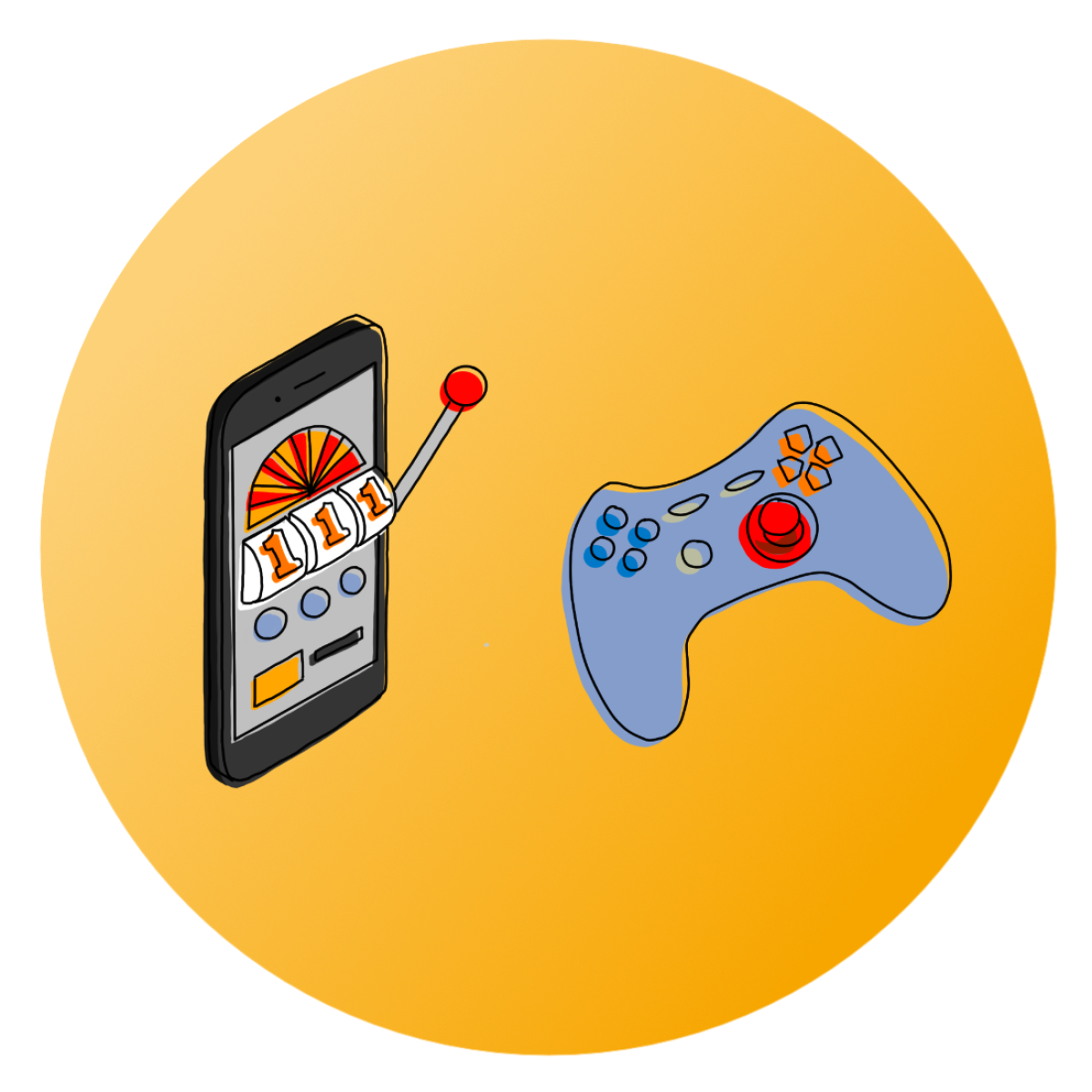
RP7: Assessment of in-game craving and inherent factors in gaming and online gambling in semi-natural settings and biofeedback-guided cue exposure training
RP7 investigates gambling-immanent factors in gaming and online gambling disorders and aims to uncover similarities, differences and interactions between the two disorders. One focus is on the modification of addiction-specific responses through biofeedback-guided cue exposure training (CET). The study consists of two parts: In the first part, craving, emotional arousal and skin conductance responses (SCR) are measured in individuals with inconspicuous or pathological use of computer games or gambling. In the second part, participants undergo biofeedback-guided CET to reduce addiction-related reactions, with various measures being collected before and after the training.
Read more
RP7 focusses on the investigation of gambling-immanent factors in gaming and online gambling disorder and aims to simultaneously uncover core mechanisms (similarities, differences and interaction effects) between both disorders. Of particular interest is the modification of addiction-specific reactions through biofeedback-guided cue exposure training (CET). In current addiction research, it is assumed that close links between addiction-associated stimuli and specific behaviour play an important role in the maintenance of the disorders. An important mechanism here is cue-reactivity, which encompasses a broad spectrum of subjective, physiological and neurochemical reactions. Closely linked to cue-reactivity are craving and emotional arousal, which occur more frequently when individuals with an addiction disorder are exposed to addiction-specific stimuli. This phenomenon can be visualised using various psychophysiological measures such as the skin conductance response (SCR). Research suggests that addiction-specific responses can be modified using CET, which is why these and related variables are to be experimentally reduced using a combination of CET and biofeedback training (BT) in a proof-of-concept study. The study is therefore divided into two parts: In the first part, four groups (individuals with inconspicuous or pathological computer game use, individuals with inconspicuous or pathological gambling use, n=32 per group) will play video games and gambling in a semi-natural setting while craving, emotional arousal and SCR are measured. The results from part 1 will be used for adaptive testing in part 2. In Part 2, participants in all groups will be exposed to computer game and gambling videos while undergoing biofeedback-guided CET via SCR. Craving, emotional arousal, implicit associations and SCR are measured before and after the training. As the training aims to modify addiction-related reactions, it is expected that craving, emotional arousal and implicit positive associations will be reduced after the training. In order to analyse the mechanisms optimally and realistically, the study will be conducted in a semi-natural setting. RP7 has clear synergies with RP2 and RP8 (both proof-of-concept studies) and RP11 (gaming disorder and gender aspects).
Project members
Principal Investigator: Dr. Klaus Wölfling, Prof. Dr. Sabine Steins-Löber
Members: Nanne Dominic
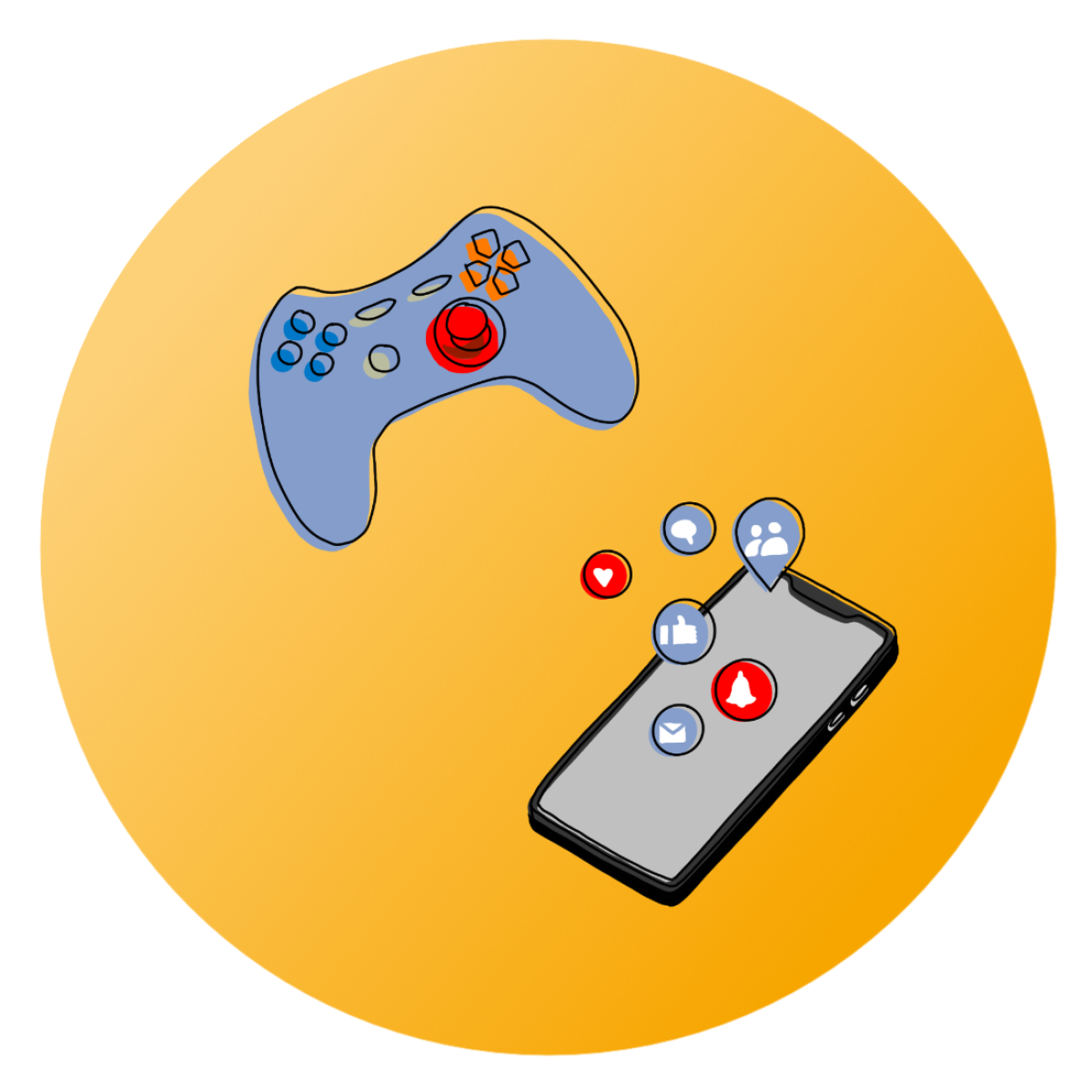
RP8: Emotional working memory training and cognitive bias modification in social network use disorder and gaming disorder
RP8 examines explicit and implicit cognitions in substance use disorders and behavioural addictions such as social networking and computer games, including expectancies of use, emotion dysregulation and inhibition control. The study aims to test the efficacy of emotional working memory training (eWMT) and cognitive bias modification (CBM) on these cognitions. It is expected that eWMT will have a stronger effect on explicit cognitions and CBM a stronger effect on implicit cognitions, whereby the effects will be investigated in a laboratory and an extended home training programme.
Read more
According to dual process models, explicit and implicit cognitions play a crucial role in the development of substance use disorders and behavioural addictions. Explicit cognitions can include usage expectations, emotion dysregulation and inhibition control, which have been shown to be risk factors for the development of mental disorders as well as addictions. Implicit cognitions such as approach/avoidance tendencies, implicit associations and experiences of gratification and compensation are also associated with an increased risk of addiction. Emotional working memory training (eWMT) has been shown to be effective in reducing symptoms of psychological and - according to an initial pilot study - internet use disorders. In addition, improved inhibition control was observed compared to the placebo group. The effectiveness of Cognitive Bias Modification (CBM) has already been demonstrated in the area of alcohol use disorders. A pilot study with excessive multiplayer online gamers has shown that automatic behavioural tendencies were reduced. RP8 aims to extend the results of the first funding period with regard to the role of explicit and implicit cognitions. According to the preliminary results (RP8 first funding period), positive and negative usage expectations as well as the experience of gratification and compensation differed significantly between unproblematic, risky and pathological users of social networks. In addition, the implicit associations were found to be highest among pathological, followed by risky and unproblematic social network users. In the second funding period, the effects of eWMT and CBM on emotion dysregulation, approach/avoidance tendencies, implicit associations, inhibition control, usage expectations and the experience of gratification and compensation will now be investigated in a proof-of-concept study. It is expected that eWMT will have stronger effects on explicit than implicit cognitions and CBM will have stronger effects on implicit than explicit cognitions in individuals with social network use disorder (SNN) or computer gaming disorder (CSS). The study utilises a cross-sectional design with within and between individuals with SNN (n=68) and CSS (n=68). Participants are assigned to the eWMT or CBM condition. The training takes place over two days in the laboratory. In an exploratory part of the study, the effects of extended training conducted at home will be tested in a follow-up examination after one month. RP8 is closely related to RP2. Both RPs investigate the effects of CBM on affective and cognitive mechanisms in individuals with CSS. In addition, synergistic effects are expected with RP5 and RP11, which both address inhibitory control in SNN.
Project members
Principal Investigator: Prof. Dr. Hans-Jürgen Rumpf, Dr. Elisa Wegmann
Members: Lasse Schmidt, Lena Klein

RP10: Cue reactivity and craving in buying-shopping disorder and social network use disorder: Neural correlates, attentional bias, and media-specific features
Cue-reactivity and craving are central mechanisms in substance use and behavioural addictions, with neuroimaging studies showing activity in the ventral and dorsal striatum. A new cue reactivity paradigm from the FOR2974 research group shows that distal cues can trigger cue-reactivity and craving in various internet use disorders. In RP10, this paradigm will be used to investigate the neural correlates of buying-shopping disorder and social network use disorder and compare the results with previous studies to paint a comprehensive picture of specific Internet use disorders.
Read more
Cue-reactivity and craving are central constructs in substance use disorders and behavioural addictions. Neuroimaging studies of cue-reactivity and craving in gaming disorder have shown activity in the ventral and dorsal striatum and other structures involved in fronto-striatal loops. Initial studies suggest that the ventral and dorsal striatum are also involved in the processing of purchase-related images in buying-shopping disorder and of images associated with social networks (e.g. "likes") in social network users. In the first funding period of the FOR2974 research group, we developed a new cue-reactivity paradigm that includes both proximal (e.g., direct presentation of game or pornography content) and distal cues (e.g., presentation of the login page of a game or pornography website). This paradigm was used in RP4 of the first funding period to investigate neural correlates (fMRI) of cue-reactivity in computer gaming disorder and pornography use disorder. We were able to show that even the distal cues, which are very comparable across applications, can trigger cue-reactivity and craving. In RP10, we will use this paradigm to investigate the neural correlates of buying-shopping disorder and social network use disorder. We will use the same fMRI protocol as in the first funding period of RP4. Therefore, we will be able to compare the results not only between the groups in RP10, but also with the groups included in the first funding period in RP4, in order to draw a complete picture of the four types of specific Internet use disorders that the FOR2974 research group is focussing on. We will study six groups (with 37 participants each): individuals with 1) buying-shopping disorder, 2) risky buying-shopping behaviour, 3) social network use disorder, 4) risky social network use and 5) or 6) control participants who use both shopping and social networks unproblematically and are matched according to age and gender to the two groups of pathological users. In addition, we will investigate cue-reactivity and craving as well as punishment sensitivity in everyday life using ambulatory assessment. Finally, we will also use the proximal images of the cue-reactivity paradigm and additional standardised images of shopping sites and social networks to investigate possible effects of media-specific features on attentional processes (performance in a change-blindness flicker task). RP10 shows strong correlations with RP4 of the first funding period as well as with RP3 (cue-reactivity and punishment sensitivity in everyday life), RP4 (cue-reactivity and craving) and RP5 (attention processes, buying-shopping disorder and social network use disorder).
Project members
Principal Investigator: Prof. Dr. Matthias Brand, Prof. Dr. Rudolf Stark, Prof. Dr. Nicole Krämer
Members: Jana Theisejans, Faye Oueslati
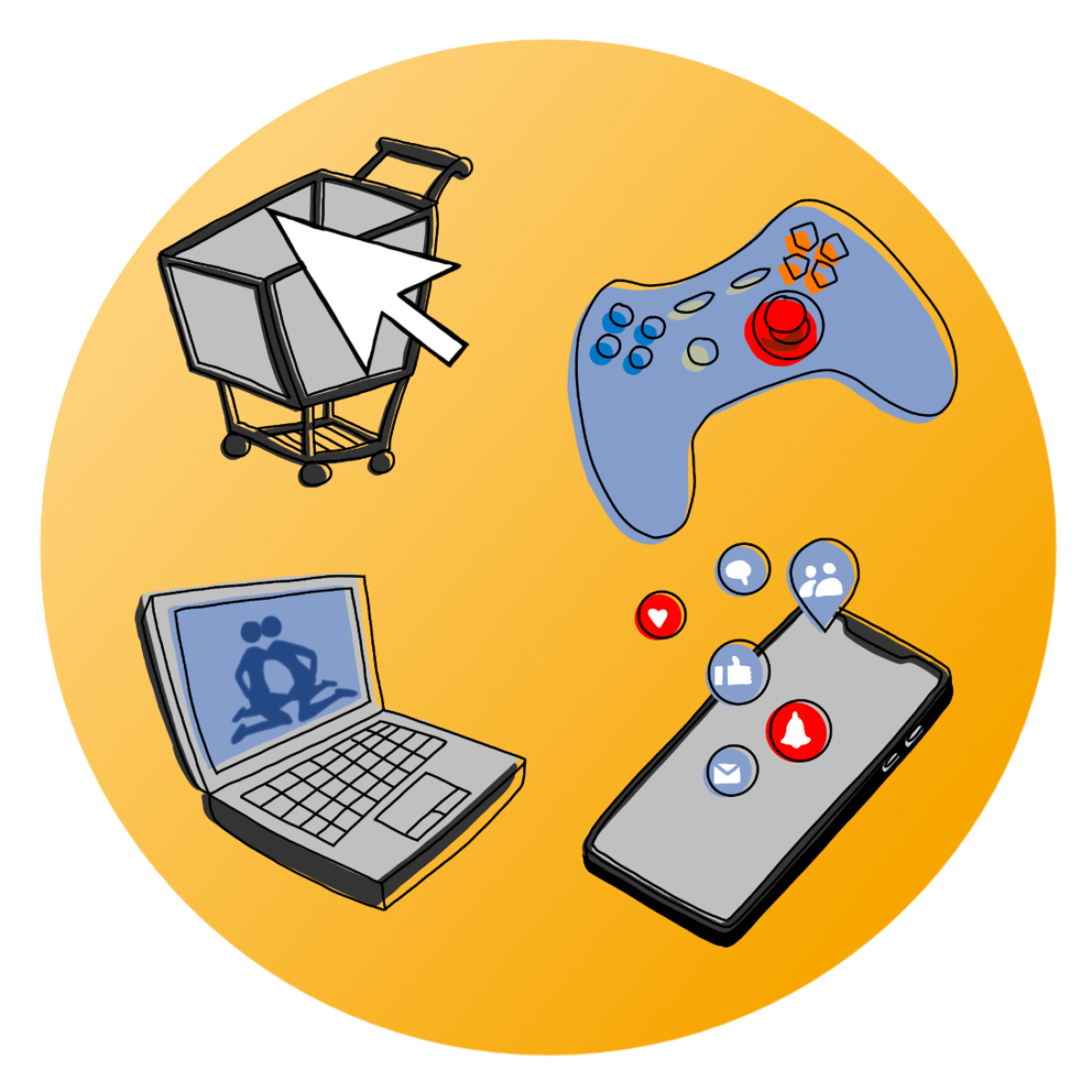
RP11: Sex-/gender-related aspects in affective and cognitive mechanisms of gaming disorder and pornography use disorder
RP11 investigates gender-specific mechanisms in gaming disorder and pornography use disorder using the developed cue-reactivity paradigm and the modified Iowa Gambling Task. Initial results show that distal stimuli can trigger craving in males. RP11 now compares responses in female participants in four groups (with n=32 each) to analyse gender differences and explore qualitative aspects such as illness representations and media-specific content.
Read more
Female participants are significantly underrepresented in research on gaming disorder and pornography use disorder. However, initial work on gender differences in gaming disorder demonstrates the importance of considering gender-specific mechanisms in the development and maintenance of these two specific Internet use disorders. RP11 addresses the investigation of affective and cognitive processes in females with gaming disorder and pornography use disorder compared to females with unproblematic use. The central concepts of FOR2974, in particular cue-reactivity and craving as well as executive functions and decision-making behaviour and their interactions are considered. The cue-reactivity paradigm developed in the first funding period of FOR2974 with distal stimuli (e.g. login page of computer games, logos of pornography sites) is applied, as well as the modified Iowa Gambling Task with specific addiction-related stimuli (as in RP4 of the first funding period). Results from the first funding period show that distal stimuli can trigger craving responses in males with computer game or pornography use disorder. In RP11, we will use the same behavioural measures from the cue-reactivity and decision paradigms as RP4 (with male participants) in the first funding period to investigate the hypothesised effects on female participants. This will allow us to compare the results not only between the groups in RP11, but also with the groups from RP4 in the first funding period to test for gender-specific differences in particular. In the experimental part, we will include four groups (n=32 each): females with 1) gaming disorder, 2) unproblematic use of computer games, 3) pornography use disorder, 4) unproblematic use of pornography. In addition, RP11 will comprise two work packages (WPs), each with qualitative parts. One WP will focus on gender differences with regard to individual disease representations in people with pathological use behaviour (including self-stigmatisation, subjective disorder models and use of support services). Another WP will focus on media-specific aspects and content. In both WPs, (group) interviews will be conducted on all four types of specific Internet use disorders investigated in FOR2974 in order to paint a complete picture. The results of the qualitative studies are used as a basis for further quantitative surveys. An inclusive approach to various sex and gender dimensions is taken into account. RP11 has strong links to RP4 of the first funding period as well as to RP3, RP4 and RP10 of the second funding period.
Project members
Principal Investigator: Dr. Silke M. Müller, Prof. Dr. Sabine Steins-Löber, Prof. Dr. Nicole Krämer
Members: Tom Malte Burkardt, Faye Oueslati

